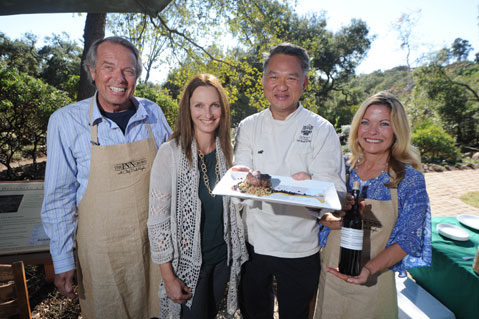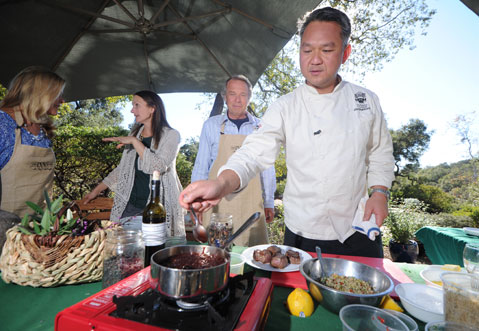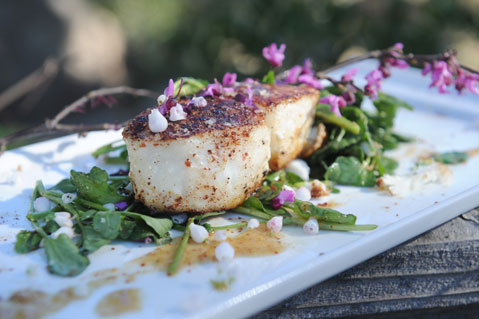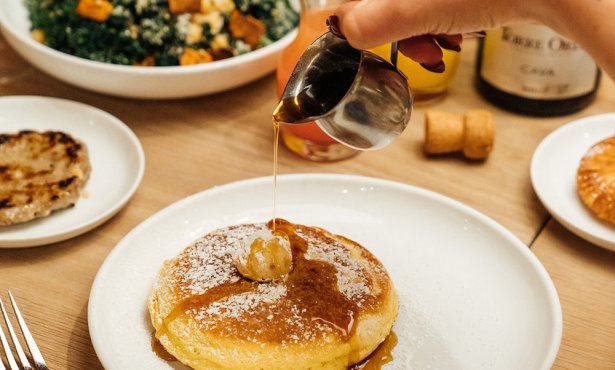Chef Budi Kazali Lives Wild, Eats Gourmet
Going Hyper-Local on Cable Television with Alicia Funk

In between the occasional buzzing of helicopters above, the Ballard Inn’s Budi Kazali is making gourmet food look easy despite cooking on a sizzling should-be-summer day in January on mobile stoves outdoors at the Santa Barbara Botanic Garden. He’s taping an episode of his The Inn Crowd TV program, and while the menu features typical fare like halibut, its true stars are items like manzanita, toyon, elderberries, cattail pollen, and oak nut flour.
That’s because his guest is Alicia Funk, co-author with Karin Kaufman of Living Wild: Gardening, Cooking and Healing with Native Plants of California. “I sent Chef Kazali packages brimming with California native ingredients that you can see growing in the S.B. Botanic Garden,” she explained. “He used the recipes from my book as a starting place and used the ingredients to highlight the taste of the meat and seafood available locally. He seemed genuinely curious and interested, since many of the ingredients were available from plants growing in abundance outside his back door.”

It’s a collaboration that pushes the locavore movement to an apex of sorts. “Wild foods provide a nutrient-dense source of food that grows here without a lot of extra effort,” said Funk. “Oak trees can grow on steep hillsides without irrigation and some species can produce up to 2,000 pounds of acorns per tree per year. Native foods reduce shipping distances and allow us to enjoy local food without the significant water, compost, fertilizers of commercially popular garden foods from Europe.”
While Kazali is certainly jazzing up what could be demeaned as gathered nuts and berries by using Santa Ynez–raised buffalo as his meat, he also seems jazzed about having such fresh, unusual flavors like just-picked bay leaf and the cattail pollen, vivid as saffron. “It’s really interesting to learn about the edible natives we have here in Santa Barbara and to get to know their flavors and textures and how they would work when combined with other foods,” said the Foodie Award–winning chef. “It’s great to have a professional to help you to know what plants are edible. I certainly wouldn’t trust myself in that department!”
Indeed, before you try this at home, Funk warned to never gather anything that you cannot identify with 100 percent accuracy. “My recommendation is to change over the landscaping around your home to include native plants so that you have a drought-resistant, easy-to-gather source of our native food,” explained Funk. “The Botanic Garden has an extensive selection of native plants for sale in their nursery and the experts that can help you grow them.”

The Wild Food Menu
Manzanita cider: Explained Funk, “Manzanita berries are three times higher in antioxidants than blueberries and make a refreshing beverage that was enjoyed traditional by the indigenous inhabitants of California.” It looks like a lightly brewed tea but has a fuller flavor than its color would lead you to expect.
Halibut crusted with manzanita and toyon berries: “I gather the manzanita berries in the summer and sift and grind them into a sweet, gluten-free flour,” said Funk. “The toyon berries I gather in the winter and then dry and grind into a spice. It is reportedly the bush Hollywood was named after, as the plant, with holly-shaped leaves, used to cover the Hollywood Hills.” The resulting crust is both slightly sweet yet tangy, too, perfect to accentuate the fleshy fish.
Watercress salad with manzanita vinaigrette and blossoms: “The dressing recipe is in my book,” said Funl, “and provides a delicious tanginess to spring greens and is especially beautiful when garnished with winter-blooming manzanita blossoms.”
Seared buffalo in elderberry sauce, with bay leaves and pine nuts: “California bay is an evergreen tree, with a strongly aromatic leaf, which grows near local creeks,” Funk explained. “Pine nuts have been a significant source of food in this landscape for thousands of years, but most commercially available pine nuts in the stores are imported from China.” The California ones taste even pinier, given they haven’t traveled far.
Oak nut marzipan dusted with golden cattail pollen: This dessert “is gluten-free with oak nuts and almonds and then dipped into organic dark chocolate,” said Funk. “Gluten-free oak nuts — that is, acorns — are high in vitamin A, folate, and omega-6 fatty acids.”
4•1•1
Catch this episode of how to cook with native plants on The Inn Crowd on KEYT3, Saturday, February 22, at 6:30 p.m. More information about Alicia Funk and her book Living Wild is available at livingwild.org.



